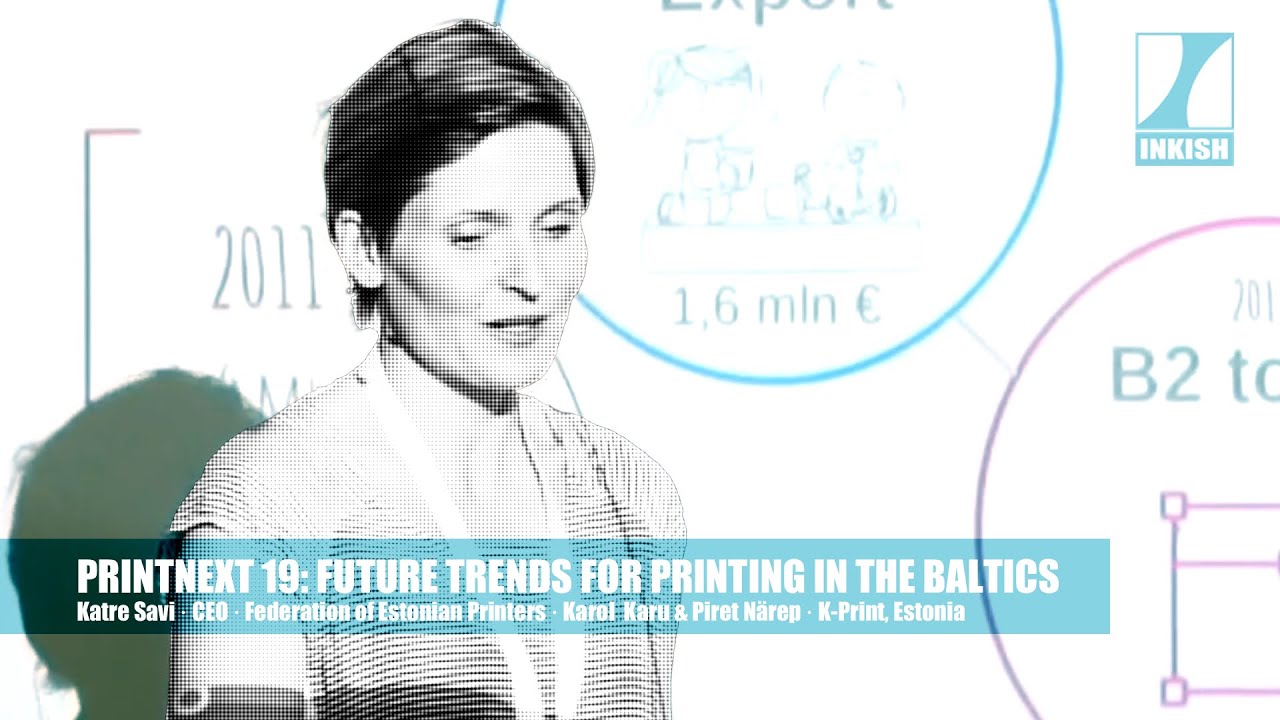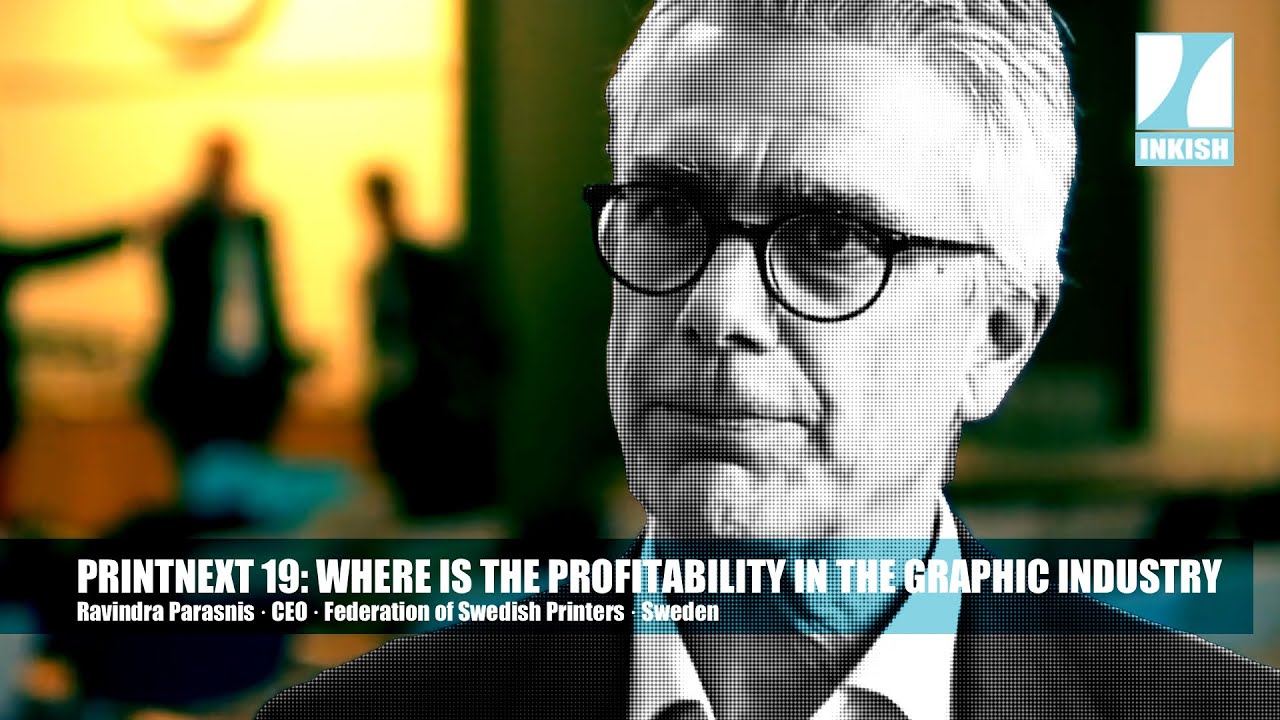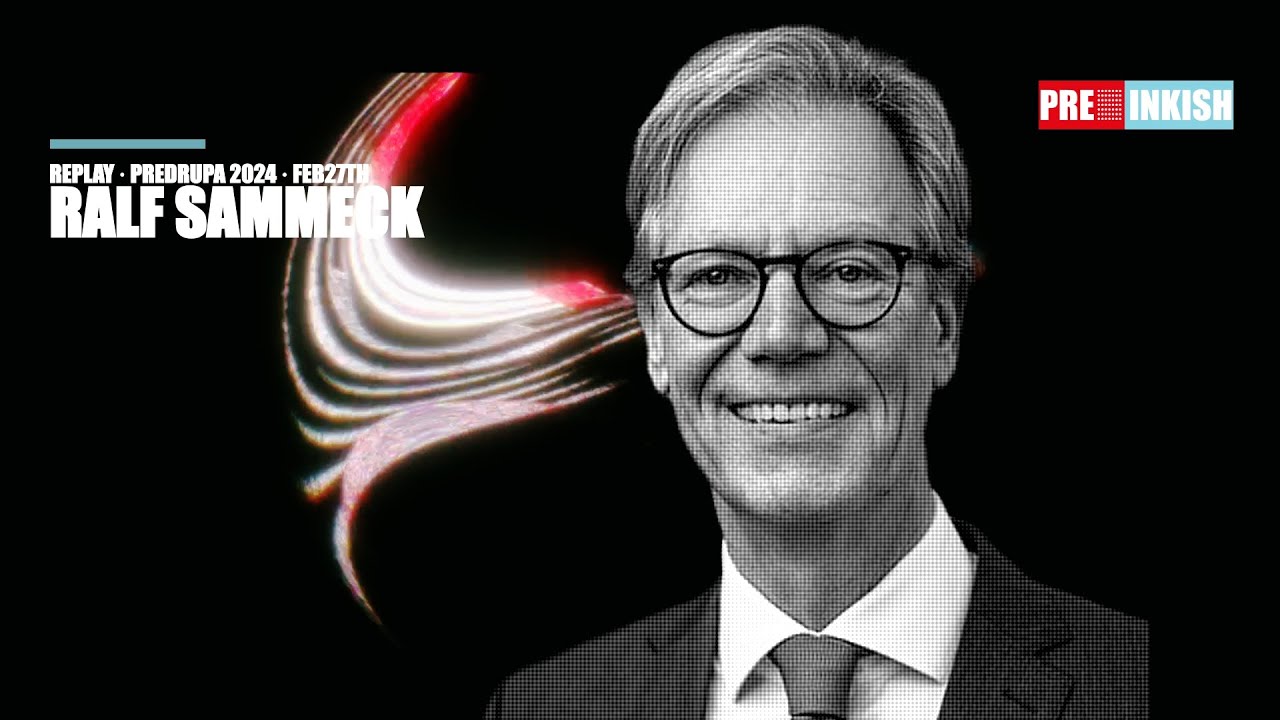For many Scandinavian print buyers, the Baltics has been an interesting market to work in and for many printing companies, the Baltic printing industry has been a challenge due to lower prices and tough competition. At PrintNext19, Katra Savi from Association of Estonian printers talks about the market and how they are focusing more on quality than price. Katre Savi is accompanied by two Account Managers from the Estonian printing company K-Print who share their insight in the work in especially the Swedish market – Actually a great presentation!
Proud to be here. My name is Katre, I said. I am from association of Estonian printing and packaging industry. In your program it said that the session will be about future trends in Baltic countries. It’s made clear and simple. It’s Print in Estonia, so we have done it. No other trends.
I will give you an overview, what is it to print in Estonia and why to print in Estonia? There is only 1.3 million of us, and we have small area like Netherland or Denmark, but for Estonia it has never been much in the way of resources or internal markets because we are small. On the other hand it’s our advantage to do things smart and to find out effective solutions. In Estonia you can meet a lot of bright ideas and can do spirit. I think most of you know Estonia by this sentence that we are most digitalized society. There is all government services it’s offered by digital way. There is only three things which you can’t do in digital. This is getting married, getting divorce, or making any real-life transactions. We tried to get this added to it also to the other sectors, like for industry. Our future is smart industry. A lot of digitalized and automatization solutions, automized.
[inaudible 00:02:22] what is this Estonian printing industry? At first, there is the association which has quite long history. Since 1996, so it started as a printers union. In 2016, there was also involved the packaging companies, and so is the new name, Association of Estonian Printing and Packaging Industry. We are also a member of a European association Intergraf. In our association there is 41 members and they are printing and packaging companies, suppliers, and also] which is really important for us.
These are all our companies who we have together. There are book printers, there are magazine newspaper printers, different kind of digital printers. Like I said, packaging companies and suppliers and so on. In the way we have all parts of the printing industry to get together.
If you see Estonia in European markets, so you can see it’s a really small one, but we have long history and I think we have bright and innovative future. Numbers are small, but we have a certain place for the whole European market. According to statistics, we have nearly 400 printing companies, but as you see nearly half of them are with so small turnover that we are not calculating them as active printing companies. There are those who are really doing this business, there is 150. Something like that. These numbers, so it’s only printing companies. There are not packaging companies because they are in material based sectors. To see also the number of European all together, what there is, really huge.
This, I think, the segments are quite similar for other European countries as well is that there is small part for newspaper and magazine printers, very stable book printing, and bigger one is all kind of advertising materials and commercial materials. What can I say that the newspapers and magazines are a little bit going down. Books are quite stable. Smaller print runs, but more and more names to print. This all advertising materials, catalogs, this is growing. Also growing labor printing and packaging. The printing products are everywhere. We can see them, a lot of interior design and so on. It’s more and more innovative products will come up.
As we are so small country, then the export is really important for our printing industry, and you can see that 53% of Estonian printing industry total turnover comes from export and in this case we can say that as we are so called from politics and our [inaudible 00:06:05] base, Russia, but today we are definitely more influenced by Scandinavian countries and the export market which are open and innovative as we are.
You can see that the most important export partners for Estonian printing companies are Finland, Sweden, then Lithuania, Norway, Latvia. You can see also the number of companies who have clients in these countries. We have smart and hard working people in Estonia. Our unemployment rate is really low. Our average salary is growing and there is around 3000 people working in printing industry, but we need them more and more, so the printing companies are getting bigger and there is a changing of generations. We have one school in Estonia where you can study printing technology and there is four study fields: printing machine operators, graphic pre-press operator, post press operator, and digital print operators.
They are all in so, or at school, so it’s very practical studies and you can see this poster is what we are doing in association together with companies that every year we have campaign in streets, so to invite young people to choose printing industry.
Why print in Estonia? I think we are all in the global market, so it’s not anymore that we are competing to Latvia or Lithuania, or we are competitors for Swedish companies. We are all in the same market, so it’s more and more the same things matters. For Estonia I would say that one of the most important thing is that we have new technology and new equipment. All companies invest a lot for newest technology. This will offer fast delivery times and also the highest quality. Hand by hand it’s done. It’s also a lot of done by craftsmanship, so it’s really important.
Print companies has multilingual sales team, so if you are clients from Finland or Sweden, they all can speak to Estonian printing companies on their own language and we have skilled workers. Our companies are small, so they are really looking for clients and they are offering very good services, or offering better services. Our companies are certified and this environmental thinking is more and more important. I think there is much to think about in choosing a print partner.
That’s already said in here today we have quite big group of Estonians. We have 11 companies in here. I hope you can meet them. I hope you can find the way to do business together and to give you an opportunity to understand the Estonian printing company life, or everyday life, even better. I would like to introduce our printing company, K-Print, and they are a very good example of young and enthusiastic people. They have put a lot of effort to digitalization and automatization. Their product range is wide and they deliver worldwide. I give the floor soon to them, but I hope that in future, they are partners in this printing industry and we can do a lot together. Now I will give the floor to Karol and Piret from K- Print. Then we have questions later if you do have.
Yeah, yeah. Totally.
Another question before you leave the stage Katre. It’s quite high percentage for the Nordics companies, Finland, Sweden, but also Norway it’s quite … Who are the customers? Are they the end customers or are there other printing companies? I guess do you see any developments there or is it-
Actually I think this is a question for a printing house, so I’ll leave this question to them.
Okay.
For my point of view, as we have such a wide range of companies, they are all different. It’s even like when we talk about the Baltics, I even say that all these countries, Estonia, Latvia so different because our economies are different. It’s also in the internal industry, if you talk about Estonian printing industry, the companies are so different. It’s because of societies, which are they are focusing for, and so on. That’s, yeah.
Online print?
Yes.
Actually again, the question for printers. as companies are looking for new services and new markets, so online printing is one of them. These printing companies who do digital printing, they are a step closer to these services, so they’re already companies who offer these kind of things.
Okay, thank you. We move onto K-Print, and you will all be together at dinner tonight.
My name is Piret and this is my colleague, Karol. We are responsible for export market in Sweden. We are from K-Print, which is a 27 year old printing house, printing house located in. The main products that we do are brochures, folders, and maybe a little bit special printings like packaging with hot foil and embossing. Mm-hmm (affirmative).
Probably you might have noticed that we are not the oldest one here. Most of the people that we talk to have been in the printing industry for maybe almost 100 years. That’s what we say.
It’s honest to say that we’re not here to teach you anything about printing today, since most of you probably have more knowledge about it than we do. Like Katre said, there are a lot of printing houses in Estonia, several of them here today as well. It would be really hard to represent them. What we’re doing here today is we’re telling you our story and how K-Print got to where we are today.
Mm-hmm (affirmative). Let’s begin from my story. I’ve been working at K-Print for eight years. I started like that. My course mate, who is now the CEO of the company, his father is the owner of K-Print, and he knew I could speak Swedish, so he asked me if I could work for K-Print and maybe do some sales calls and answer some emails. It escalated a lot and after only one year time, I found myself making the phone calls, doing sales, being a full time project manager meeting the customers in Sweden, and maybe helped to find out new strategies for K-Print as well.
I think we were both very ambitious, young university students aiming to grow.
We have this picture on the screen there because in the beginning it really felt like we were a few kids playing in a sandbox, because we came directly from a university, started doing sales strategies, export plans, market analysis, and we really didn’t understand how big the things were we were actually doing. Seven years ago, when I first started doing sales calls in Swedish, I could barely speak any Swedish, but we still decided to do it that way. I had my sales talk all written out, but when somebody was replying, I didn’t really understand what they were saying back to me.
It turns out it went pretty well and that there were people that weren’t turned off by my broken Swedish. With the joint effort of the whole team, we were actually able to double our turnover just within a year.
Yeah, so in 2013, we went from B2 size to B1. We bought the new offset printing machines. With that we also changed our perfect binding machine to certain packets today. Müller-Martini, I think there’s a representative from there today as well. Then we bought two folding machines and also a wire binding machine, and moved to a bigger location.
Together with the new machinery, we expanded to Finland and we hired four new people to our sales team, and we quickly realized that getting new employees isn’t the easiest task because it turns out that working in a printing house isn’t the most prestigious job to have. We didn’t really realize that before but it really hit me when I was having a conversation with a friend who was changing jobs he asked me for advice. It went like, “Karol, you know how people need to have a purpose behind what they’re doing, and you need to feel that you’re doing something meaningful. How do you find motivation since you’re, you know, selling paper?” I hadn’t thought about it because I always felt very motivated and I thought that what I’m doing is very important and important to my customers offering a really, really good customer service, important to the company, important to Estonia developing exports.
We just needed to find the people who would feel the same way, who were ambitious, bold, and maybe just a little bit naïve. It still is an ongoing process for us in K-Print.
Then we have to come up the ways to make our work more effective. We started automatization in K-Print. We actually first calculated all the prices in Excel, and then we implemented the Heidelberg business manager. It’s a very good system that is connected with all the machinery in our printing house, and also we can see the live feed on where one project is being produced on which machine and when it’s going to be ready. This gives us chance to focus on the things that are more important to us, or most important to us: finding new customers, helping them, just being a printing specialist, which is very important today.
That actually continues to be our main focus today as well, automating all the possible processes in the printing house from project management to price calculation through Heidelberg’s business manager system, to automating the workflow of print files from our customers to pre press and also automating sales. We started developing our social media to generate the leads more efficiently. A really good example of the effectiveness of automation is a business card project that we’ve been doing for the past three years.
This year we’re printing 1.5 million business cards to 500 people from six different countries. How it used to work was that every single person would send an email with an order and a picture to a person who gathered all orders. The designer would make all the files one by one, and then send it back to the person, and then they send it to us. It was all a big, big hassle. What we did this year is we set up with web shop so every single person could just go in there, insert their data, the data that’s going to go on the business card, and also the data that is needed for the order, so a phone number and so on. They could just attach their picture over there and then what they get back is an approval link to their email.
If they hit the approve or accept button, then the order is sent directly to our pre press. It made things a lot easier for the people ordering cards to the designer. She didn’t spend any time on this year. It saved a lot of time for us. We really believe that those kind of changes and those kind of automated processes are what are going to help us, that are going to help bring us closer to our big, ambitious goals in the future.
Just to sum up, after eight years of hard work, we have started to export to Sweden, Finland, Netherlands, Norway, Denmark, and Germany. We export 75% of our turnover today. We believe that the main key to our success has been mindset of our people, always aiming to grow and believing in ourselves. That’s it. Thank you.
‘Future Trends of the Printing Industry in the Baltics’ – Presentation by CEO Katre Savi.
Download the presentation here.
Download the presentation from K-Print here.































